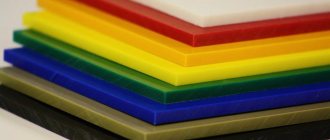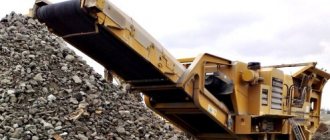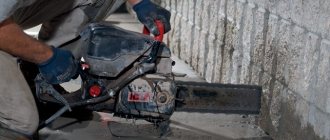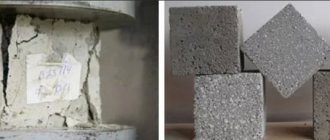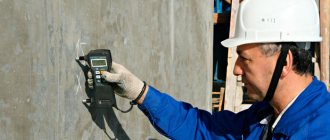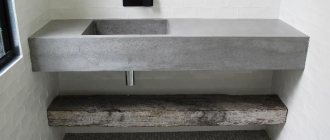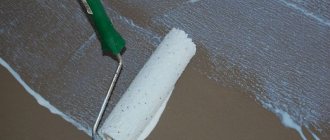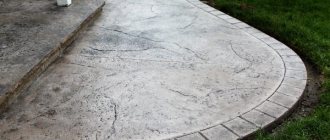In damp conditions, mold forms on concrete structures - dark spots of various shapes that spoil the cosmetic appearance of the walls. They can appear on both concrete walls and plaster. This fungus is not able to destroy concrete structures unless it has been on them for decades, but its spores spread to other interior items - furniture, household appliances, plastic structures, clothing and destroys these things. But the main danger of the fungus is that it enters the human body through the respiratory tract and gastrointestinal tract and causes diseases of the respiratory tract and other internal organs.
Therefore, after construction, concrete walls must be treated with special septic tanks that penetrate deep into the concrete structure and protect it from mold.
Definition and purpose
An antiseptic for concrete is a special impregnation that penetrates the pores of concrete and protects it from the influence of the external environment, in this case from the penetration of fungus into them.
The function of an antiseptic is to protect the surfaces of concrete products not only from the destructive effects of mold and moisture; the antiseptic also copes with the following tasks:
- protection of concrete from all microorganisms;
- reducing the impact on concrete of chemicals entering the product from the outside;
- protection from ultraviolet radiation and temperature changes;
- the antiseptic binds the molecular structure of concrete and strengthens it.
Special means - antiseptics
To remove fungus, preparations produced in the form of a primer or impregnation are used. They produce product brands designed for a specific type of fungus and universal formulations that fight all types of microorganisms and are suitable for indoor and outdoor use. Antiseptics for concrete against mold are bactericidal preparations that can destroy microorganisms and fungal cells and prevent their further reproduction. Several types of antiseptics are produced:
- Water soluble. Copious application of such compounds ensures deep impregnation of the surface being treated. Refers to non-combustible materials.
- Using organic solvents. These are toxic compounds; when working with them, you must strictly adhere to safety rules.
- Oil based. Experts consider this type of product to be the most effective antiseptic against fungus.
- Multicomponent combined concentrates. In their pure form they are used to eliminate mold, and in diluted form – for the purpose of prevention.
A mandatory component of any anti-mold impregnations and primers, regardless of the base, are fungicidal substances.
Manufacturers indicate all characteristics and properties of the product on the label.
Areas of application of antiseptics
Concrete surfaces in residential and non-residential premises are treated with an antiseptic, primarily those where high humidity is expected, and there are objects made of other materials that are more susceptible to destruction by fungus than others.
It is also used to treat brickwork, artificial stone coverings, foundations, concrete supports and the base of swimming pools.
Depending on the area of application, antiseptics are of the following types:
- Water soluble . They are used on surfaces that do not have reinforcement, since these septic tanks contain substances that destroy steel reinforcement, so the use of antifungal agents of this type is very narrow.
- Organic antiseptics . Used for impregnation of surfaces made of concrete, brick, ceramic tiles and artificial stone. They are very toxic, so personal protective equipment must be used when working with them. Protect the surface from fungus for several years.
- Combined antiseptics . The production technology is more complex than the previous ones, so they are more efficient. They consist of various solutions diluted with water in different proportions. They eliminate fungus and prevent spores from germinating into the microstructure of concrete.
Causes of mold on the floor
There are only two reasons for the appearance of such unpleasant neighbors as mold fungi.
- Insufficient waterproofing, and as a result, increased humidity.
- Poor ventilation.
Moreover, it is worth eliminating these causes not only in the apartment or house itself, but also in the basements located underneath them. A moldy floor is probably the result of processes that are invisible to you and taking place in the lower tiers.
The fungus never starts in a dry and warm room that is regularly ventilated. If you find signs of fungal plaque, examine the condition of the sewer drain. Chances are, even if there are no cracks, the drainpipes are not insulated. The condensation released can cause parasites to multiply.
Why you can't ignore mold growth
Many people do not understand the reasons why they need to treat the floors in the house at the slightest sign of mold. Not understanding the principle of fungal reproduction, some people reason like this: “As long as it is not visible, why spend so much effort removing mold from walls, floors and ceilings?”
Meanwhile, it has already been proven that mold fungi reproduce by microscopic spores. Once inside the interior of an apartment or house, they “hover” in the air. Constantly being in such a room, you risk becoming infected through the respiratory tract and skin pores. It is worth getting rid of mold on floors only because the human body is an ideal place for the proliferation of fungal spores. They absolutely do not care where to live - in the underground or in the lungs of a person.
Having settled in the respiratory tract or lungs, mold can cause serious diseases:
- pulmonary tuberculosis;
- bronchitis;
- various allergies;
- asthmatic manifestations.
Once in the human body, spores contribute to a significant decrease in immunity and affect the internal microflora. This is why removing mold from wood floors should be a top priority if there are small children, pregnant women, or elderly people in the home. These categories of people are especially at risk of deteriorating health after such infection.
Causes of fungus on concrete
To prevent further spread of the fungus and prevent its appearance in other rooms, you should know the causes of mold:
- An inefficient heating system leading to high humidity – a favorable environment for fungus.
- Insufficient air exchange or lack of ventilation, which additionally allows fungal spores to spread throughout the room.
- Insufficient thermal insulation of the building from the outside.
- Poor quality waterproofing of installation joints and building foundations.
- Laundry is drying in the room.
- The presence of indoor plants in large quantities.
Mold on concrete and other materials
Building structures based on mineral binders (cement, gypsum) - concrete, mortars and plasters - are characterized by the presence of small air pores in their volume, into which moisture and mold spores can enter. The waste product of mold is the release of solutions of acids and alkalis, which gradually dissolve cement stone and gypsum compounds. A sign of the presence of mold are spots of black, blue and green, and a sign of structural damage is swelling and peeling.
Often the food medium for the development of mold is salts dissolved in water, which entered the structure with moisture from the environment.
During new construction and reconstruction, to combat the causes of mold, the following measures must be taken:
- Construct foundation structures from concrete with increased water resistance. For this purpose, a water-repellent concrete additive CEMMIX CemAqua
- it provides volumetric water-repellency, reduces water absorption, and prevents the appearance of efflorescence and mold. - External structures must be vapor-permeable, but treated with a water-repellent composition CEMMIX CemAquaStop
- a product for treating the surface of building structures to prevent the appearance of fungi and mold. - Installation of reliable waterproofing of all building structures from the foundation to the roof, in all wet rooms, on balconies, loggias, terraces. Prevent the penetration of moisture through seams and junctions, including in places where various communications pass (water supply, sewerage, electricity, heating mains, etc.) - Provide normal heating, ventilation and air conditioning (in accordance with current building codes SP60.13330.2012 “Heating, ventilation and air conditioning”).
- If mold appears on the surface of building structures, then it is necessary to take measures to destroy the mold that has appeared and clean the structures with special compounds. To do this, chemical fungal cleaning agents (fungicides or antiseptics) are used. We recommend using CEMMIX Biocid
- this is a concentrate that is used for prevention and also for the destruction of mold on affected surfaces. CEMMIX Biocid also protects against damage by fungus, algae, moss, and is effective indoors and outdoors.
Work on treating the affected areas is carried out several times, depending on the degree of damage, until the mold is completely destroyed. When performing this work, you must follow the manufacturer's instructions.
Homemade remedies against fungus and mold
Sometimes folk remedies are used against fungus, one of them is vinegar and soda. Before treating infected surfaces, scrape off all the fungus with a spatula and wipe the walls with a rag soaked in vinegar or spray the product onto the walls with a spray bottle.
To obtain a soda solution, simply dilute a teaspoon of soda in a glass of water and apply a homemade antiseptic to the infected walls with a rag or spray. It is important to treat even hard-to-reach surfaces to ensure that fungal colonies are destroyed. If, after treating with soda and vinegar, mold appears again, it is necessary to use special means to combat the fungus.
How to get rid of mold on linoleum using folk remedies
Every person has to deal with mold. And in addition to black mold, white rot may also appear in the house, which can quickly ruin a wooden floor .
At the same time, it will also smell very strongly. People began to fight fungi a long time ago; a lot of methods have accumulated; we have identified the most effective ones. You can cope on your own using only improvised means if the lesion is insignificant. When there are huge stains, it will be difficult to completely destroy these microorganisms, and the resulting mold smell is also unlikely to be removed.
Copper sulfate
Copper sulfate gives a good effect. Dissolve it in a ratio of 0.1 kg of powder per bucket of water. For heavily grown fungus, it is sometimes recommended to increase the dose of powder by 2-4 times. Some also add vinegar (0.2 l) or a chlorine-containing preparation.
When working with this product, you should take precautions - protective gloves, goggles, a respirator and thick clothing.
Lemon acid
Fungal spores react negatively to acids. Therefore, citric acid will come in handy here. If the mold outbreak is not large, it is enough to dilute 5 tbsp. in 1 liter of water and treat the affected surface with the solution.
Chlorine and similar products
Preparations containing chlorine compounds help to effectively get rid of not only the mold itself, but also destroy its spores along with the smell of rot. You will need 1 liter of product per bucket of water (regular Whiteness bleach will also work).
Work should be done using personal protective equipment in a well-ventilated area.
Borax
Many properties are attributed to this product - fungicide, herbicide, insecticide. For mold, borax is a strong poison that inhibits its development . It is necessary to dilute 4 cups of the product in a bucket of water and treat the surface several times.
Ultimately, borax will not only destroy the entire fungal colony, but also create a protective film on the floor . Therefore, it is not recommended to wash off the solution from the surface .
Antiseptic for treating walls against mold and mildew
You can read how to plaster brick walls here.
Concrete walls under wallpaper. Remove wallpaper and wash walls with mildew remover.
After drying, treat with a deep penetration antiseptic, after which you can begin finishing. See how to properly hang wallpaper here.
Plasterboard sheathing. Drywall affected by mold will have to be dismantled and thrown away. If the sheathing is made of wood, it should be removed and treated with a wood antiseptic. Clean the walls of mold and treat with a suitable deep penetration antifungal agent. Reinstall the plasterboard structure. Read how to cover walls with plasterboard here.
During the work, pay special attention to window openings - if the window installation is carried out incorrectly, the slopes or the space under the window sill freezes and becomes damp, creating favorable conditions for the development of fungus. It may be necessary to dismantle the slopes or window sill in order to properly insulate the structure using polyurethane foam or other suitable materials. How to effectively insulate and finish slopes, see here.
